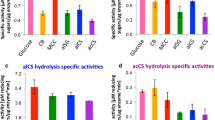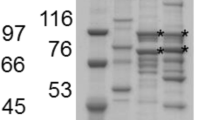Abstract
Clostridium straminisolvens (CSK1) is a novel cellulolytic bacterium isolated from a cellulose-degrading bacterial community MC1. In this study, the influence of the following cell disruption and elution methods on CSK1cellulase release was investigated: (1) freezing–thawing, (2) ultrasonication, (3) elution, (4) freezing–thawing following elution, (5) ultrasonication following elution, and lastly (6) high-pressure homogenization following elution. The activity of the cellulases CMCase, β-glucosidase, Avicelase, FPase, and xylanase in crude extracts increased 81.5, 23.8, 87.7, 46.3, and 51.7 %, respectively, with an observed optimal treatment method for each cellulase type. The release of protein from CSK1 cells increased following either cell disruption or elution and was highest at 88.3 % in the homogenization high pressure following elution treatment. A newly observed protein was present following cell elution. The performance of cell elution as determined by real time-PCR indicated that the first time cell elution removed more than 90 % of the CSK1 cells from the substrate. These findings demonstrate that cell disruption and elution are effective methods for inducing cellulase release, and elution is the key step for CSK1. To our knowledge, this study presents the first evidence of optimal treatments for induction of cellulase release of Clostridium straminisolvens. This information will be of great value for use in subsequent efforts to better understand the cellulase characteristics of CSK1 and cellulose degradation mechanisms of the MC1 community.







Similar content being viewed by others
References
Stephanopoulos, G. (2007). Science, 315, 801–804.
Kerr, R. A. (2007). Science, 316, 188–190.
Jin, W., Yan, F. C., Mao, S. Y., & Zhu, W. Y. (2011). Bioresource Technology, 102, 7925–7931.
Demain, A. L., Newcomb, M., & Wu, J. H. (2005). Microbiology and Molecular Biology Reviews, 69, 124–154.
Sizova, M. V., Izquierdo, J. A., Panikov, N. S., & Lee, R. L. (2011). Applied and Environmental Microbiology, 77, 2282–2291.
Himmel, M. E., Ding, S. Y., Johnson, D. K., Adney, W. S., Nimlos, M. R., Brady, J. W., & Foust, T. D. (2007). Science, 315, 804–807.
Lewis, S. M., Montgomery, L., Garleb, K. A., Berger, L. L., & Fahey, G. C., Jr. (1988). Applied and Environmental Microbiology, 54, 1163–1169.
Feng, Y., Yu, Y., Wang, X., Qu, Y., Li, D., He, W., & Kim, B. H. (2011). Bioresource Technology, 102, 742–747.
Yang, H., Wu, H., Wang, X., Cui, Z., & Li, Y. (2011). Bioresource Technology, 102, 3546–3550.
Cui, Z. J., Li, X. M., Piao, Z., Huang, Z., Ishii, M., & Igarashi, Y. (2002). Environmental Science (In Chinese), 23, 36–39.
Haruta, S., Cui, Z. J., Huang, Z., Li, X. M., Ishii, M., & Igarashi, Y. (2002). Applied Microbiology and Biotechnology, 59, 529–534.
Guo, P., Zhu, W. B., Wang, H., Lü, Y. C., Wang, X. F., Zheng, D., & Cui, Z. J. (2010). Journal of Microbiology and Biotechnology, 20, 254–264.
Kato, S., Haruta, S., Cui, Z. J., Ishii, M., Yokota, A., & Igarashi, Y. (2004). International Journal of Systematic and Evolutionary Microbiology, 54, 2043–2047.
Lynd, L. R., Weimer, P. J., van Zyl, W. H., & Isak, S. (2002). Microbiology and Molecular Biology Reviews, 66, 506–577. table of contents.
Lamed, R., Setter, E., & Bayer, E. A. (1983). Journal of Bacteriology, 156, 828–836.
Holdeman, L. V., Cato, E. P., & Moore, W. E. C. (1977). Anaerobe laboratory manual (124th ed.). Blacksburg: Virginia Polytechnic Institute and State University.
Ghose, T. K. (1987). Pure and Applied Chemistry, 59, 257–268.
Beukes, N., & Pletschke, B. I. (2006). FEMS Microbiology Letters, 264, 226–231.
Bradford, M. M. (1976). Analytical Biochemistry, 72, 248–254.
Sambrook, J., & Russell, D. W. (2001). Molecular cloning: a laboratory manual. Vol 3, 3rd edition. New York: Cold Spring Harbor Laboratory Press, Cold Spring Harbor.
Zhu, H., Qu, F., & Zhu, L. (1993). Nucleic Acids Research, 21, 5279.
Kato, S., Haruta, S., Cui, Z. J., Ishii, M., & Igarashi, Y. (2004). FEMS Microbiology Ecology, 51, 133–142.
Gautam, S., & Simon, L. (2006). Biochemical Engineering Journal, 30, 104–108.
Bayer, E. A., & Lamed, R. (1986). Journal of Bacteriology, 167, 828–836.
Yolcubal, I., Pierce, S. A., Maier, R. M., & Brusseau, M. L. (2002). Journal of Environmental Quality, 31, 1824–1830.
Zheng, H. L., Yin, J. L., Gao, Z., Huang, H., Ji, X. J., & Dou, C. (2011). Applied Biochemistry and Biotechnology, 164, 1215–1224.
Acknowledgments
This work was supported by a grant from the National Natural Science Foundation of China (No. 30800672), Scientific and Technological Innovation Programs of Higher Education Institutions in Shanxi (No.20091010), and the rural biogas technology supporting Project of China (No. 201303080-7).
Author information
Authors and Affiliations
Corresponding author
Additional information
Jungang Wang and Jiajia Li contributed to this work equally and are joint first authors.
Rights and permissions
About this article
Cite this article
Wang, J., Li, J., Liu, J. et al. Influence of Cell Disruption and Elution on Cellulase Release of Clostridium straminisolvens (CSK1). Appl Biochem Biotechnol 173, 510–521 (2014). https://doi.org/10.1007/s12010-014-0857-7
Received:
Accepted:
Published:
Issue Date:
DOI: https://doi.org/10.1007/s12010-014-0857-7




